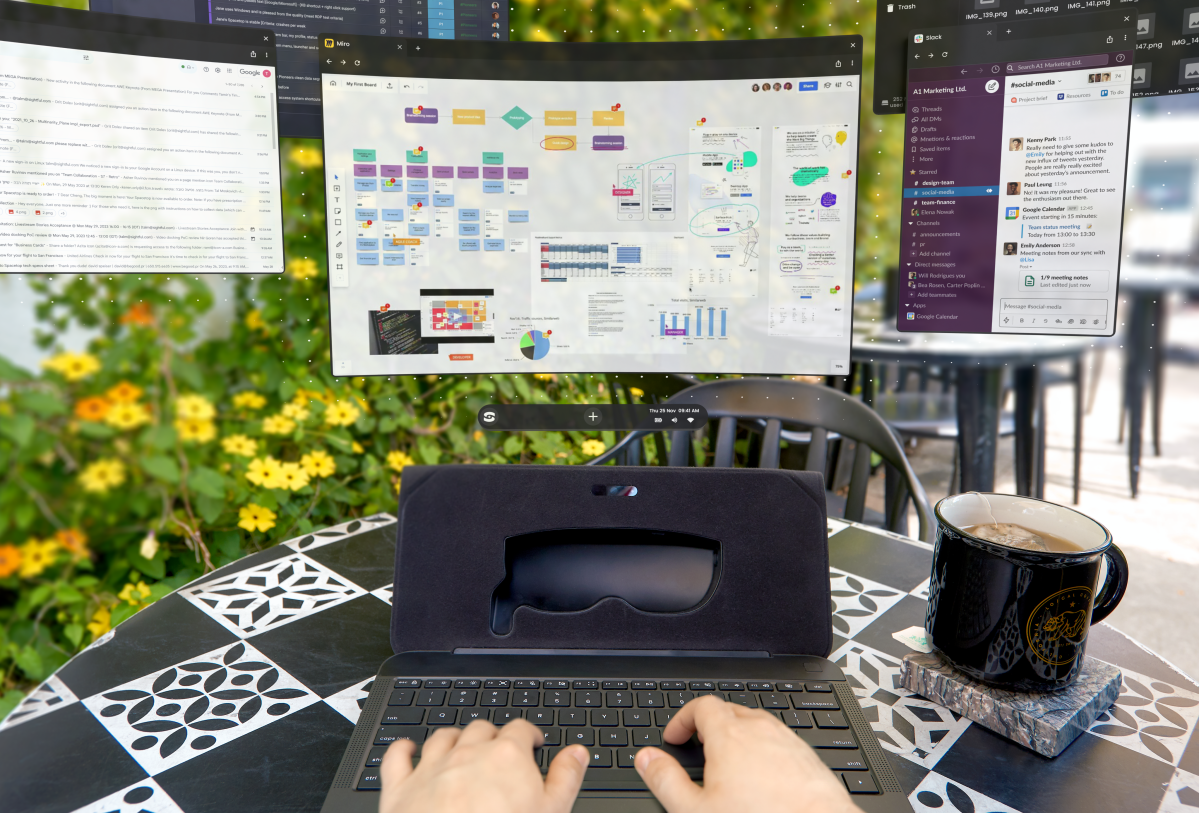Sightful’s Spacetop, the laptop with no screen that we saw demo’d last year, has entered commercial availability with the Spacetop G1, a faster, more polished version that will be available later this year for a relatively reasonable $1,900.
The Spacetop uses a pair of augmented reality (AR) goggles — in this case, a modified version of the Xreal Air 2 Pro — as a display interface. So while the SpaceTop G1 looks similar to the “early access” Spacetop that we went hands-on with last year, the performance should be significantly better. The specs are improved, and more PC-like (16GB LPDDR5, 128GB SSD) but the field of view on the glasses appears to have narrowed by a hair.
The idea behind the Spacetop, though, remains the same: A typical laptop has a single screen, but the Spacetop uses the AR glasses to project a “100-degree virtual workspace” in front of you, to which you can affix virtual windows. The remainder of the Spacetop, which includes the real-life physical keyboard tray, sits on the desk in front of you. Spacetop argues that this makes excellent sense in the cramped environs of a plane, or just in a world where you want to have the benefits of multiple monitors without the encumbrance of actual hardware.
Spacetop offered us a chance to go hands-on with the Spacetop G1; I was forced to decline, as I just couldn’t make it work with my travel schedule.
Sightful
What has improved in the Spacetop G1
The Spacetop G1 improves on its predecessor in a number of ways.
Sightful’s Spacetop begins with the glasses, and the company says “a variety of modifications” have been made here. The glasses now project at 90Hz, rather than 72Hz, at the same 1080p resolution as before. But the display panels are now OLED, which generally offers a more pleasant visual experience on desktop PCs, at least.
The field-of-view (FOV), however, has shrunk. Sightful says that the FOV measures 50 degrees, down from 53 degrees in the early-access product. But that’s not bad, compared to, say, older Xreal glasses like the Air XR (46 degree FOV). Apple hasn’t disclosed the FOV of the Vision Pro, but it’s surmised to be more than 90 degrees in either direction, according to Macworld. That can present a tradeoff: A wider FOV means more distance between the pixels, resulting in a grainier view. Spacetop has left the pixels-per-degree (PPD) fixed, at 42.

Sightful
Sightful also says that it has tweaked the structure of the glasses, adjusting the comfort and balance. The latter was a weak point in the early device, in my opinion. One of the interesting twists is that Sightful is still offering custom prescription lenses for the glasses, from =8.00D to +6.00D. If you enter your prescription while buying the Spacetop G1, the lenses will ship right in the box.
Inside, Sightful also includes a faster processor: the Qualcomm QCS8550, a chip designed for Internet-of-Things applications, rather than a laptop chip like Qualcomm’s Snapdragon X Elite. A Sightful spokesman said that the chip inside the Spacetop G1 includes 48 TOPS of compute power. In any event, that should produce snappier interactions.
It’s not clear whether there’s a bigger battery, but the Spacetop G1 also includes more battery life: seven hours, up from five hours. It can be charged from 0 percent to 85 percent in less than two hours. But the weight of the device has slightly dropped, too, to just 3.08 pounds, including the glasses, which weighs a lighter 0.19 pounds.
The Spacetop G1 still looks like the early-access model: a squished burrito that unfolds into a more conventional keyboard and workspace. From my older experience, the glasses panned smoothly about the virtual workspace, which was essentially Android; at the time, the windows and apps weren’t as smooth as a real PC.

Sightful
I don’t know if Sightful has solved that problem. But with a faster processor and more memory, things look more promising.



